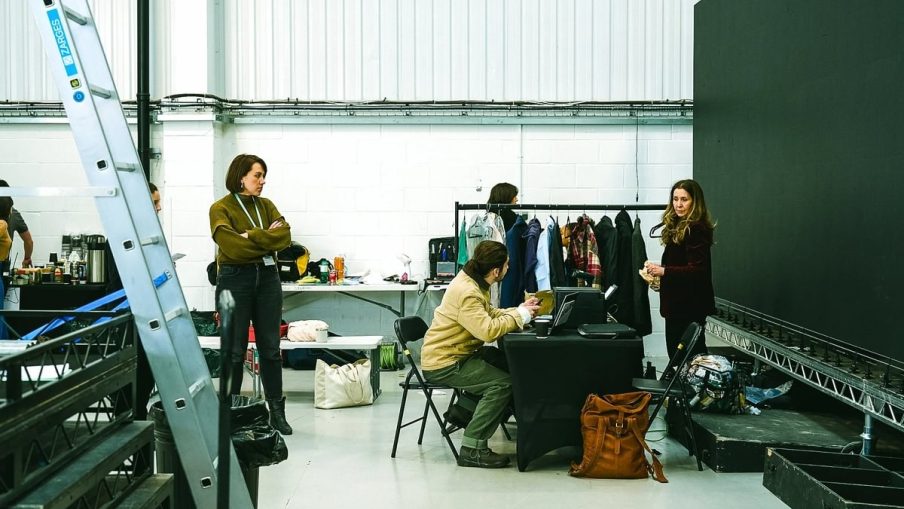Class and mental wellbeing in the UK film and TV industry

As conversations around class representation gain momentum across our industry, this new piece investigates the link between class and poor mental health – and considers how the industry can take action to create lasting change.
A recent report by Ampere Analysis for ScreenSkills and 4Skills found that:
31% of the screen industries workforce are from working-class backgrounds* compared to 39% among the wider UK population
Another report from the Creative Industries Policy and Evidence Centre suggested that working class representation is even lower at about 25%, which matches the profile of respondents to our latest Looking Glass survey.
Barriers people face in the UK screen industries
In a report from 2021 focusing on class inequality in the UK’s screen industries, Creative Industries Policy and Evidence Centre in 2021 outlined the various barriers to ‘getting in’ and ‘getting on’ in the industry for people from working-class backgrounds.
The report explains that these barriers stem from disparities in the financial, social and cultural capital of those from different class origins.
These disparities span the life course, from early life and post-16 education, to entering and progressing in work. The disparities, which tend to disadvantage individuals from working-class backgrounds, also intersect with industry norms, such as:
- Informal recruitment practices
- Reliance on personal networks and the prevalence of unpaid internships
Whilst representation of people from working class backgrounds has received attention, the link between class and mental wellbeing is less well understood. To the best of our knowledge, it has not previously been explored among off-screen workers in UK film and TV.
Class and mental wellbeing: what Looking Glass 2024 reveals
As shown below, Looking Glass respondents from working-class backgrounds were more likely to rate their mental health as ‘poor’ or ‘very poor’ compared to those from intermediate or professional backgrounds.
They were also more likely to report feelings of loneliness in the workplace and to have experienced bullying, harassment or discrimination over the past 12 months.
Whilst the differences presented are statistically significant, they are relatively modest at around 4–6 percentage points. It should be noted that the proportion of respondents from intermediate or professional backgrounds with ‘poor’ or ‘very poor’ mental health is itself much higher than the average UK worker (reported by CIPD to be 18%) but, clearly, even higher for those from working-class backgrounds.
Whilst class background on its own may not seem to make much difference to an individual’s experience, it seems to have the effect of amplifying other identity-related barriers.
Intersections of class and other characteristics
Intersectionality refers to the way various aspects a person’s identity ‒ such as class, race, gender, or sexual orientation ‒ interact to shape their experiences and how they are perceived by others.
Rather than examining each identity characteristic in isolation, an intersectional approach considers how an individual with more than one marginalised identity characteristic can face exacerbated challenges.
How class deepens mental health risks for film and TV professionals
Our 2024 Looking Glass survey showed that there were nine discernible subgroups who were at greater risk of suffering from poor mental health and/or experiencing adverse conditions or behaviours in the industry.
These nine groups are included in the chart below, which shows the proportion reporting poor or very poor mental health and overlays a class dimension to the nine demographic characteristics.
Interestingly, the chart shows that being from a working-class background seems to ‘amplify’ the poor mental health ratings within each of these groups, albeit to varying degrees. The amplification appears greatest – a difference of 10 percentage points or more – for the following:
- LGBTQ+ respondents
- Black and Global Majority respondents
- Neurodivergent respondents
- Women
What the data tells us about the industry
The data from Looking Glass 2024 adds to a developing discussion and recognition that class matters. It matters not just in terms of access and opportunity, but also in how it interacts with other elements of an individual’s identity and how it influences their mental wellbeing and experiences of working in the industry day-to-day.
Drawing on academic literature, reasons for the mental wellbeing differences discussed above may stem from childhood socioeconomic advantage being associated with positive mental wellbeing in childhood, which is in turn associated with adult mental wellbeing.
It has also been suggested that individuals from lower socio-economic backgrounds may be less likely to access mental health support, or, when they do, only doing so only at crisis point. This shows a need to target and promote support and resources to those who are most vulnerable.
Loneliness and mental health in the film and TV industry
Our wider research has also shown that loneliness is a key driver affecting overall mental health. Our recent report on loneliness highlights how individuals from under-represented or marginalised backgrounds may experience a lack of social identity affirmation within professional spaces, contributing to feelings of loneliness and, consequently, worse mental health.
This last point links back to the importance of tackling areas of under-representation in the industry’s workforce. As a first step, it highlights the need for measuring and reporting data on class representation. As James Graham said in last year’s MacTaggart lecture “If we don’t measure it we can’t fix it. We need to be honest about who’s in the room – and who’s not.”
We will be doing our bit by continuing to collect class-related data in our surveys and ensuring it features in our analysis to better understand which groups are at greatest risk of poor mental health and in greatest need of support. If we want an industry that is truly inclusive and supportive of the mental health of its workforce, class can no longer be a missing piece of the conversation.

Keep in touch
Sign up to hear more about new research, support services, events, industry news and much more
Footnote
*Class origins are based on parental occupation at the age of 14 and are coded to the National Statistics Socio-Economic Classification (NS-SEC).
‘Working-class backgrounds’ are assigned to those whose main household earner were employed in lower supervisory and technical occupations, routine or semi-routine occupations, or who were long-term unemployed.